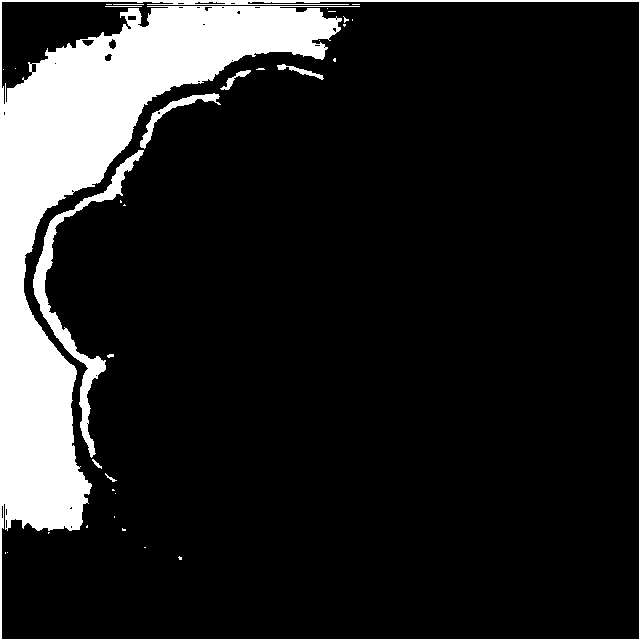Bacillus licheniformis for decomposing feathers of pigeons and application of bacillus licheniformis
A technology of Bacillus licheniformis and feathers, which is applied in the application field of environmental resources in aquaculture, can solve problems such as poor effect, and achieve the effect of promoting ecology
- Summary
- Abstract
- Description
- Claims
- Application Information
AI Technical Summary
Problems solved by technology
Method used
Image
Examples
Embodiment 1
[0034] Example 1: Culture identification of bacterial strains.
[0035] 1. Obtaining the original strain
[0036] Sampling 5 grams of pigeon manure deposits from a pigeon farm in Nanjing, directly inoculated the collected soil with a sterilized inoculation loop on an ordinary agar plate, cultured at 37°C for 24 hours, observed the shape of a single colony grown, and the diameter of the bacteria was about 2mm , with irregular edges, pale brown, coarse-shaped colonies ( figure 1 ). Carry out further isolation and culture, after obtaining a single colony, carry out pure culture. Bacterial isolation and culture results: A purely cultured bacterium was obtained through bacterial isolation and culture, named NJ-01. The isolated bacteria were in the shape of petals under a 400-fold low-power microscope ( figure 2 ). The bacteria were observed under the oil microscope after Gram staining, and the result was G with spores. + Medium-sized bacilli, most of which are single, and a ...
Embodiment 2
[0051] Example 2: Fermentation of Bacillus licheniformis CCTCC NO: M2013489.
[0052] (1) Activation of Bacillus licheniformis strain NJ-01
[0053] Streak the Bacillus licheniformis strain NJ-01 on the activation medium with an inoculation loop, and culture it in a constant temperature incubator for 48 hours, and set the culture temperature at 37°C;
[0054] (2) Preparation of seed solution
[0055] After activating the strain described in step (1), inoculate 1 to 2 single colonies into 30 to 40 mL of seed medium with an inoculation loop under aseptic conditions, and shake and culture at 35 to 40° C. for 24 to 36 hours to obtain a seed liquid;
[0056] (3) Preparation of fermentation broth
[0057] Shake flask fermentation: Inoculate the seed solution in a shake flask with a fermentation medium with a volume of 40% to 60% of the volume of the flask at an inoculum volume of 5 to 10%, at 35 to 40°C, at 120 to 200 rpm Shake the bottle at a speed of 48-60 hours to ferment for ...
Embodiment 3
[0063] Embodiment 3: Bacteria observes the decomposition form of pigeon feather flakes.
[0064] The bacteria NJ-01 isolated and cultivated can decompose the pigeon feather flakes without adding any nutrients, and the decomposition results are as follows: Image 6 , Figure 7 , Figure 8 , Figure 9 Control without strain. The feather patterns observed each day are:
[0065] Primitive pinnae: The complete feather stem can be seen, with many slender barbules branching out from it, and several thinner barbules protrude from each barb, and the small hooks on the connected barbules are connected to each other, and the feathers are in the form of a net shape structure.
[0066] On the fifth day, the feather flakes: the quills are still intact, the barbs become soft, the barbs disintegrate, the barb hooks dissolve, the feather network structure disappears, and the appendage part disappears.
[0067] Feather flakes on the 10th day: Feather stems were soft, barbs disappeared, ba...
PUM
| Property | Measurement | Unit |
|---|---|---|
| diameter | aaaaa | aaaaa |
Abstract
Description
Claims
Application Information
 Login to View More
Login to View More - R&D
- Intellectual Property
- Life Sciences
- Materials
- Tech Scout
- Unparalleled Data Quality
- Higher Quality Content
- 60% Fewer Hallucinations
Browse by: Latest US Patents, China's latest patents, Technical Efficacy Thesaurus, Application Domain, Technology Topic, Popular Technical Reports.
© 2025 PatSnap. All rights reserved.Legal|Privacy policy|Modern Slavery Act Transparency Statement|Sitemap|About US| Contact US: help@patsnap.com



